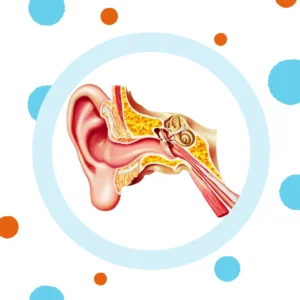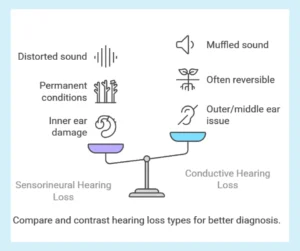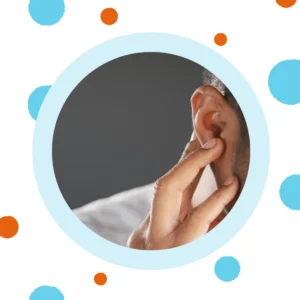
Behind the Ear Hearing Aid Tech | The Best from Injoy
If hearing aids were vehicles, behind-the-ear (BTE) hearing aids would be the tank in the group—strong, durable, and equipped with serious tech muscle. These devices

Ever feel like you’re living in a world of muffled mumbling or tinny tones? Welcome to the confusing (but fixable) world of hearing loss. Two of the biggest culprits? Sensorineural hearing loss and conductive hearing loss. They’re like the Batman and Joker of ear issues—opposites, equally dramatic, and in constant conflict over your ability to hear clearly.
Let’s walk through the ten biggest differences between these two auditory adversaries so you can figure out what’s really going on inside your ears—and what you can do about it.
Understand the dangers of untreated hearing loss.
Table of Contents
ToggleUnderstanding where hearing loss originates is key to figuring out how to fix it.
Sensorineural hearing loss occurs in the inner ear or along the auditory nerve. It’s often the result of damage to the cochlea’s hair cells or to the nerve pathways that send sound signals to the brain. Imagine the signal trying to reach your brain, but the cables are frayed, or the receiving port is broken.
Conductive hearing loss, on the other hand, happens when something blocks sound from reaching the inner ear. The issue is in the outer or middle ear, where sound waves are supposed to travel smoothly toward the inner workings of your hearing system. With this type, the problem might be a clog, a hole, or a mechanical malfunction.
In short: sensorineural = internal damage. Conductive = blocked sound path.

Both types of hearing loss have long rap sheets of potential causes, but the culprits are quite different.
Sensorineural hearing loss causes:
Conductive hearing loss causes:
Sensorineural loss is usually caused by inner ear or nerve issues, while conductive loss often results from mechanical blockage or structural defects.
Let’s say both types of hearing loss are trying to listen to the same song. How they perceive that song varies drastically.
Sensorineural hearing loss: The music plays, but the quality is bad. Think distortion, static, missing notes, or vocals that sound underwater. Even louder sounds may seem unclear, and certain frequencies—especially high-pitched ones—may vanish completely. Background noise? That’s now your enemy.
Conductive hearing loss: The sound’s integrity is preserved, but the volume is drastically reduced. Everything sounds quieter and more muted—like you’re listening with earmuffs or through a thick wall. The words are there, but they’re barely making it through.
So, sensorineural = bad sound quality. Conductive = bad sound volume.
Explore signs of hearing loss you might not expect.
One of the most important questions people ask: can I get my hearing back?
Sensorineural hearing loss is, sadly, typically permanent. The hair cells in the cochlea don’t regenerate, and once the auditory nerve is damaged, there’s no magic “undo” button. However, hearing aids and cochlear implants can help bypass or compensate for the damage.
Conductive hearing loss often can be reversed. That’s the good news. Remove the blockage (earwax, fluid, infection), fix the eardrum, or treat the inflammation, and hearing can be restored. In many cases, medical or surgical treatment works wonders.
So if your hearing loss is conductive, there’s a decent chance it’s treatable.
Let’s talk solutions. Each type of hearing loss has a different treatment path.
Sensorineural treatments include:
Find out more about assistive listening devices and hearing aids.
Conductive treatments vary depending on the cause:
Sensorineural solutions often require tech support. Conductive loss may just need a good plumber (of the ears).
Learn about hearing aid tech levels.
Sensorineural hearing loss can make understanding speech very challenging, especially in noisy places. Even with the volume turned up, the clarity isn’t there. Consonants disappear. Words blend together. It’s like hearing someone speak underwater during a drum solo.
Conductive hearing loss makes speech sound fainter but not distorted. Once the blockage is removed or sound is amplified, speech typically becomes clear again. It’s more about not being able to hear the words, rather than not understanding them.
If conversations feel like decoding encrypted messages, you’re likely dealing with sensorineural hearing loss.
Discover how get improved hearing before your next family celebration.
Sensorineural hearing loss often brings some unwanted friends:
Conductive hearing loss may come with:
So, if your ear feels plugged or sore, it’s likely conductive. If you’re dizzy and hearing phantom tones, that’s more likely sensorineural.

Another key difference between sensorineural and conductive hearing loss lies in how quickly the symptoms appear.
Sensorineural hearing loss often develops gradually over time, especially when it’s age-related or caused by long-term noise exposure. You might not even notice it at first. Conversations become harder to follow. TV volume creeps higher. You blame everyone else for mumbling. In rare cases, sensorineural loss can be sudden, typically due to trauma or viral infections—an emergency that needs immediate attention.
Conductive hearing loss, on the other hand, tends to appear suddenly and dramatically. One minute, you’re fine. The next, your ear feels blocked and sounds are muffled. Often, it’s due to something tangible—like an infection, wax buildup, or fluid from a cold. Once that cause is treated, the hearing loss may vanish just as quickly.
So if you woke up and suddenly can’t hear out of one ear, it’s probably conductive. If it’s been creeping in slowly and silently, sensorineural may be to blame.
An audiogram is a graph that shows how well you hear various tones. It’s like a fitness tracker for your ears.
Sensorineural hearing loss usually shows:
Conductive hearing loss typically shows:
These differences help your hearing care provider diagnose the exact type and degree of your hearing loss.
Let’s summarize the “geography” of your hearing system.
Sensorineural hearing loss damages the:
Conductive hearing loss damages or blocks:
One is about a broken connection to the brain. The other is about a blocked or malfunctioning sound delivery system.

Now that you understand the ten key differences between sensorineural and conductive hearing loss, you’ve officially graduated from Ear School 101. You’re more equipped than ever to take action.
Contact Injoy Hearing today and bring joy back to your ears. Your favorite sounds are waiting.

If hearing aids were vehicles, behind-the-ear (BTE) hearing aids would be the tank in the group—strong, durable, and equipped with serious tech muscle. These devices

Noise-induced hearing loss isn’t just something that happens to rockstars and airport runway workers. It’s also what happens when you crank your earbuds to 11,

When it comes to AI-powered hearing aids, ReSound Vivia and Phonak Sphere Infinio stand out. Both are prescription-only, professionally programmed devices designed for people who

So, you’ve finally got hearing aids. Cue the applause—from actual people this time, not just your inner monologue. But if you thought you’d put them
Injoy specializes in crafting custom Phonak hearing aid solutions tailored to the unique hearing needs of our patients. With a team recognized as the best in the business and decades of experience in helping people nationwide, we’re dedicated to improving your hearing and, consequently, enhancing your quality of life.
To start your journey towards better hearing with confidence, Injoy is proud to offer a 30-day risk-free hearing aid trial. This allows you to experience the difference our Phonak hearing aids can make, ensuring they meet your expectations and fit your lifestyle perfectly.
Improve your hearing and improve your life today by contacting Injoy to learn more about our risk-free trial!

Need hearing aids? Explore our range of hearing aids and discover the best option for your lifestyle and Unique Hearing Needs.
Are you a current patient with us? We're here to help with any adjustments, repairs, or support you may need.